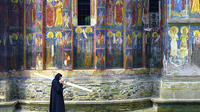Full-Day Private Tour to Bucovina from Iasi
Iași, Romania
Trip Type: Private Sightseeing Tours
Duration: 12 hours
1 day tour to admire the most famous painted monasteries in Bucovina.
More About This Activity All Private Sightseeing Tours →
1 day tour to admire the most famous painted monasteries in Bucovina.
Your day trip will start at the hotel where you will meet with your guide and start your journey to Bucovina. This region is one of the most beautiful, authentic and unspoilt rural areas in Europe, home to the Painted Monasteries, known in the UNESCO patrimony as the Churches of Moldavia. We will start the day by visiting Voronet, Romania’s most renowned monastery whose frescoes have became famous throughout the world. We continue our tour in the area with the highest density of UNESCO-listed monuments. Next on our itinerary is Humor monastery, built in 1530 with beautiful exterior frescoes. Afterwards, we will visit Moldovita monastery, built between 1532 and 1537 and included in the UNESCO heritage in 1993. Next we will visit Marginea, the only place in Europe and the second worldwide where black pottery is produced. You will be able to observe the Dacian pottery tradition carried on by a handful of craftsmen who manufacture black ceramic. Afterwards, you will be transferred back to Iasi.
Highlights
Voronet Monastery charms the visitors with its 500-year history, its legends, and especially with its artistic value. Built in 1488, the monastery’s exterior murals have preserved their hues despite centuries of inclement weather. The scenes in the murals tell the story of Christianity, influenced by folk beliefs, by the Eastern culture, but also by the Orthodox thought. The ingredients used in preparing the paints remain a mystery.
Humor Monastery – The exterior frescoes show scenes from the Lives of Saints and from the significant moments form the locals’ lives. Such a moment is the wars with the Turks, beautifully represented on the churches walls. The nuns living here have a completely separated life measuring the passing of days and nights in prayers.
Moldovita Monastery – The frescoes continue to delight the eye and the heart with their vivid colours, which have remained the same five centuries after they were painted. The murals illustrate Biblical scenes, which represented the only way uneducated country dwellers could learn about the teachings of the Bible.
Marginea Black Pottery The unique technique of moulding clay is transmitted from generation to generation, the secrets of which have never left Marginea. The black colour of the vessels is due to the firing process. The symbolic pattern that appears as ornamentation preserves directions and angles that are identical with those of the solstice and equinox. These pre-Christian symbols, discovered on prehistoric ceramics, serve to adorn today the stamp devices.
Highlights
Voronet Monastery charms the visitors with its 500-year history, its legends, and especially with its artistic value. Built in 1488, the monastery’s exterior murals have preserved their hues despite centuries of inclement weather. The scenes in the murals tell the story of Christianity, influenced by folk beliefs, by the Eastern culture, but also by the Orthodox thought. The ingredients used in preparing the paints remain a mystery.
Humor Monastery – The exterior frescoes show scenes from the Lives of Saints and from the significant moments form the locals’ lives. Such a moment is the wars with the Turks, beautifully represented on the churches walls. The nuns living here have a completely separated life measuring the passing of days and nights in prayers.
Moldovita Monastery – The frescoes continue to delight the eye and the heart with their vivid colours, which have remained the same five centuries after they were painted. The murals illustrate Biblical scenes, which represented the only way uneducated country dwellers could learn about the teachings of the Bible.
Marginea Black Pottery The unique technique of moulding clay is transmitted from generation to generation, the secrets of which have never left Marginea. The black colour of the vessels is due to the firing process. The symbolic pattern that appears as ornamentation preserves directions and angles that are identical with those of the solstice and equinox. These pre-Christian symbols, discovered on prehistoric ceramics, serve to adorn today the stamp devices.
« Go Back

